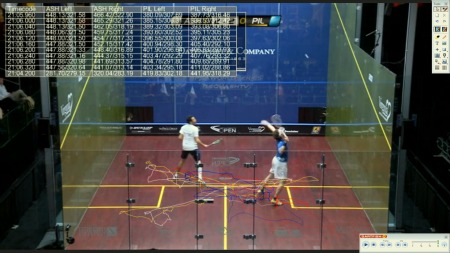
A screen shot shows how software was used to track the movements of squash players' feet.
(Edmonton) There are plenty of opportunities for undergraduate students to get involved in ground-breaking research-but only one documented case in which that research began with a game of squash.
Civil engineering professor Samer Adeeb has a special interest in biomedical engineering. But he's a well-rounded individual whose other interests include squash (though some would say it's an obsession).
This week, two undergraduate students who have taken on Dean's Research Awards projects under the supervision of Adeeb and orthopedic surgeon Dr. Nadr Johma, delivered findings on unique research they've conducted, literally tracking the footsteps of some of the top squash players in the world to see what the difference is between winning and losing.
A fourth-year engineering student in the mechanical engineering biomedical co-op program, Kris Buote took up a Dean's Research Award project this fall. The work was a continuation of research he'd started for Adeeb during a summer co-op term.
The project resulted in a new method to study a little-researched sport. Buote and Adeeb first downloaded dozens of videos of top-level squash players in competition. Then, using software called Dartfish, they "tagged" the players' feet, mapping footsteps and monitoring each player's distance, speed, and velocity.
View video of a match in which the players' feet are tracked here.
The research showed that both players in a match often run the same speed and distance (anywhere from 400 metres to nearly 1 km in the 20 videos anyalysed). In terms of total distance, players were always within four metres of one another and the average speed was 1.8 metres per second.
But the major factor in winning or losing isn't speed or distance-it's where there players play.
Buote's research verifies earlier observations that found players who stay closest to the middle of the court-marked with a 'T' that divides the playing surface into three sections-are most likely to win a match. On average, winners in the top-level matches played in a radius of 1.76 metres of the T while losers drifted in a 1.86-metre radius.
"We found the biggest difference was in a match between the top-ranked against the lowest-ranked player," he said.
Buote says the project was "a great experience" because he had the opportunity to work independently with the resources of a leading-edge lab and Adeeb's support.
"It was the first project where I applied real critical thinking to a problem I had to solve," he said, adding that there was "a lot of difficult math" involved in calculating precise positions of players' feet on the court because of the angle of the camera that recorded the videos. The view was skewed "but we were able to determine the actual co-ordinates of what is going on in the court."
Another engineering student who worked on the project under the Dean's Research Award program agrees the work was challenging. Peiqi Xi says he struggled to become familiar with software called Mathematica that he used to understand player velocity better. Knowing how to use the software gave him an advantage this semester in a class taught by Adeeb, in which Xi's fellow students were introduced to the software for the first time.
Adeeb says the DRAs give students many benefits. Some learn about engineering concepts and tools in the lab before they are even taught in class, all of them strengthen their problem-solving skills.
"The Dean's Research Awards expose students to research. It's a short-term commitment that lets them jump in, do as much as they can on a problem, and get out in six months," said Adeeb. "They're exposed to analytical methods and critical thinking."
Which brings us back around to that squash game. When Buote began working with Adeeb during his co-op placement earlier this year, the teacher schooled the student on the squash court.
"It started off with a 'lesson' and he had me running all over the court," Buote says, almost breathless at the recollection. "Then we had a game. It was, like, 11 - 3. But I've been playing a little more lately and hopefully my skills will come up and I'll ask him for a rematch."
The Dean's Research Award program gives undergraduate students the opportunity to work on research projects with professors and graduate students, giving them valuable exposure to research experience and enhancing their educational experience. The program is opened to all undergraduate engineering students with a GPA of 3.2. For more information, visit the Dean's Research Awards website.